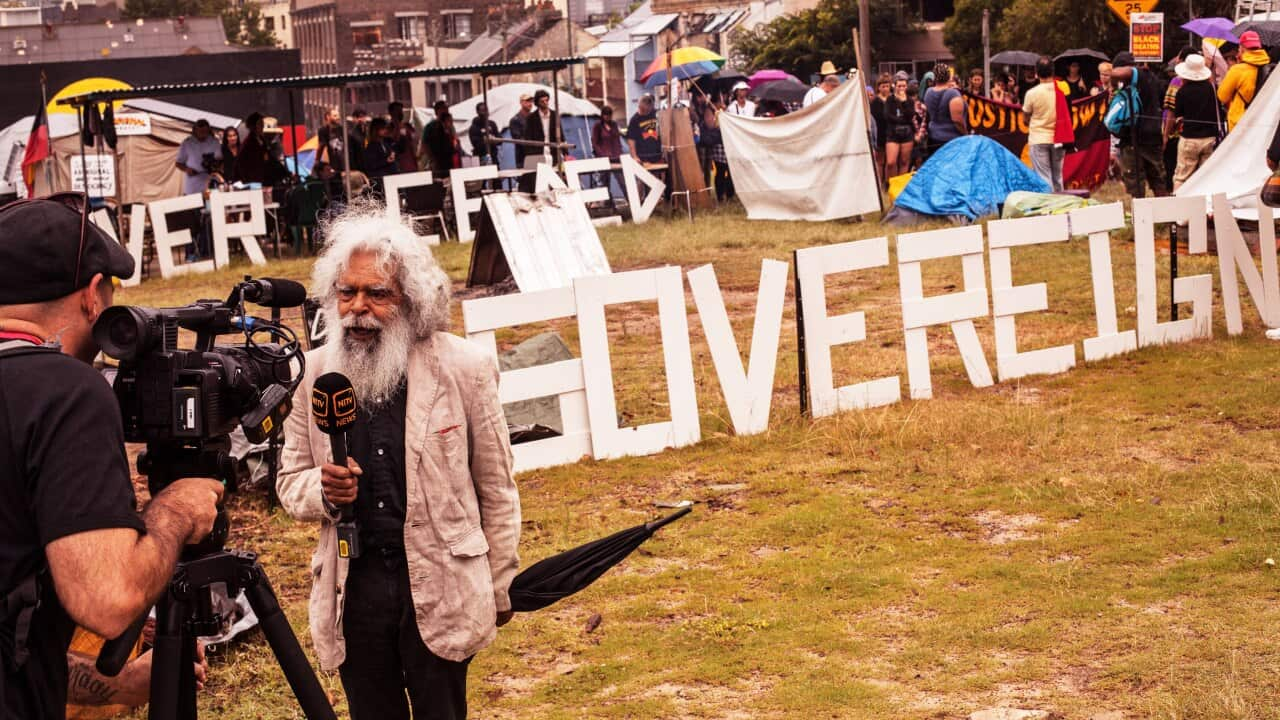On January 26 1938, a gathering at Sydney's Australia House on Elizabeth Street made history.
From the outside, it may have seemed an inauspicious event. In fact, the attendees weren't even allowed to enter through the front door: racist social convention required they use the back entrance.
It was for this very injustice, and many other more egregious examples, that the 100 or so participants had assembled.

The meeting at Australian Hall, January 26 1938. Standing at far left is Jack Patten. Source: State Library of NSW
The assembled demanded a change to these conditions and the granting of basic human rights.
It marked the beginning of the modern Aboriginal political movement.
Origins
The first Day of Mourning was the culmination of years of protest and advocacy.
In 1888, the centenary of the white arrival, a boycott of the celebrations was observed by First Nations people. The media ignored this protest, and it went largely unnoticed by colonial society.
But the push for Indigenous rights strived on, and in 1924 Worimi man Fred Maynard founded the Australian Aboriginal Progressive Association (AAPA), Australia’s first united and politically organised Aboriginal activist group.
The association was formed primarily in opposition to NSW's so-called 'Aborigines Protection Board'.

The AAPA's logo Source: National Museum of Australia
A 1915 amendment to the Act that governed the Board give them the power to remove any Aboriginal person under the age of 21 from their families, setting in motion the great Australian crime of the 20th century, the Stolen Generations.
The AAPA staged rallies, wrote to parliamentarians, published newspaper articles, and held conferences over its three-year history, before a police-driven campaign of intimidation curtailed their activities and eventually forced its disbanding.
But the work of the AAPA was to be taken up again.
The fight continues
William Cooper set up the Australian Aborigines' League (AAL) in Melbourne in 1933. The League campaigned for the repeal of discriminatory legislation, First Nations representation in parliament, and programs to “uplift the Aboriginal race”.

Yorta Yorta man William Cooper (1860-1941), a political activist and community leader who founded the Australian Aborigines' League. Source: Koorie Heritage Trust
Rights, representation and citizenship: these objectives became the core of the Aboriginal political movement.
At a meeting in late 1937, William Cooper called for a Day of Mourning to coincide with the 150th-anniversary celebrations. The APA's Bill Ferguson was present that day.
"We have been 'protected' for 150 years," said Ferguson of the Protection Boards, "and look what has become of us."
The Day of Mourning
The APA and the AAL, under the leadership of Patten, Ferguson and Cooper, worked together to organise the protest.
A sombre march from Sydney's Town Hall to Elizabeth Street invited both First Nations and non-Indigenous people to participate, but the gathering at Australia House was open only to "Aborigines and Persons of Aboriginal Blood only..."
Luminaries of the Aboriginal civil rights movement like Aunty Pearl Gibbs and Aunty Margaret Tucker were present, and in all about 100 people attended, making it one of the first mass Aboriginal civil rights gatherings.
The congress was full of staunch speakers.

Jack Patten reads the unanimous resolution calling for First Nations rights. William Cooper can be seen to his right. Source: Wikimedia Commons
The following resolution was passed with unanimous approval:
WE, representing THE ABORIGINES OF AUSTRALIA, assembled in Conference at the Australian Hall, Sydney, on the 26th day of January, 1938, this being the 150th anniversary of the whitemen's seizure of our country, HEREBY MAKE PROTEST against the callous treatment of our people by the white men in the past 150 years, AND WE APPEAL to the Australian Nation to make new laws for the education and care of Aborigines, and for a new policy which will raise our people to FULL CITIZEN STATUS and EQUALITY WITHIN THE COMMUNITY.
Legacy
The Day of Mourning, and the organisations involved, became the basis for much of the First Nations political action over the course of the century, and its legacy still exists strongly today.
The AAL convinced churches to appoint the Sunday before January 26 as "Aborigines Sunday", the first occurring in 1940 and continuing until 1955. It was then moved to the first Sunday in July.

National Aborigines Day is celebrated with speeches in Martin Place on 12 July 1963 as a policeman watches proceedings. Source: State Library of NSW
The APA and the AAL united again in the early 1960s, and became the driving force for the referendum of 1967, which granted First Nations people constitutional recognition.
And of course, though other movements like Invasion Day and Survival Day have evolved over time, the Day of Mourning has been observed every January 26 since that first meeting in 1938.
Sunset Ceremony premieres on NITV and SBS at 7:30pm on 25 January. You can also watch it later on SBS On Demand.
Join the conversation #AlwaysWasAlwaysWillBe










